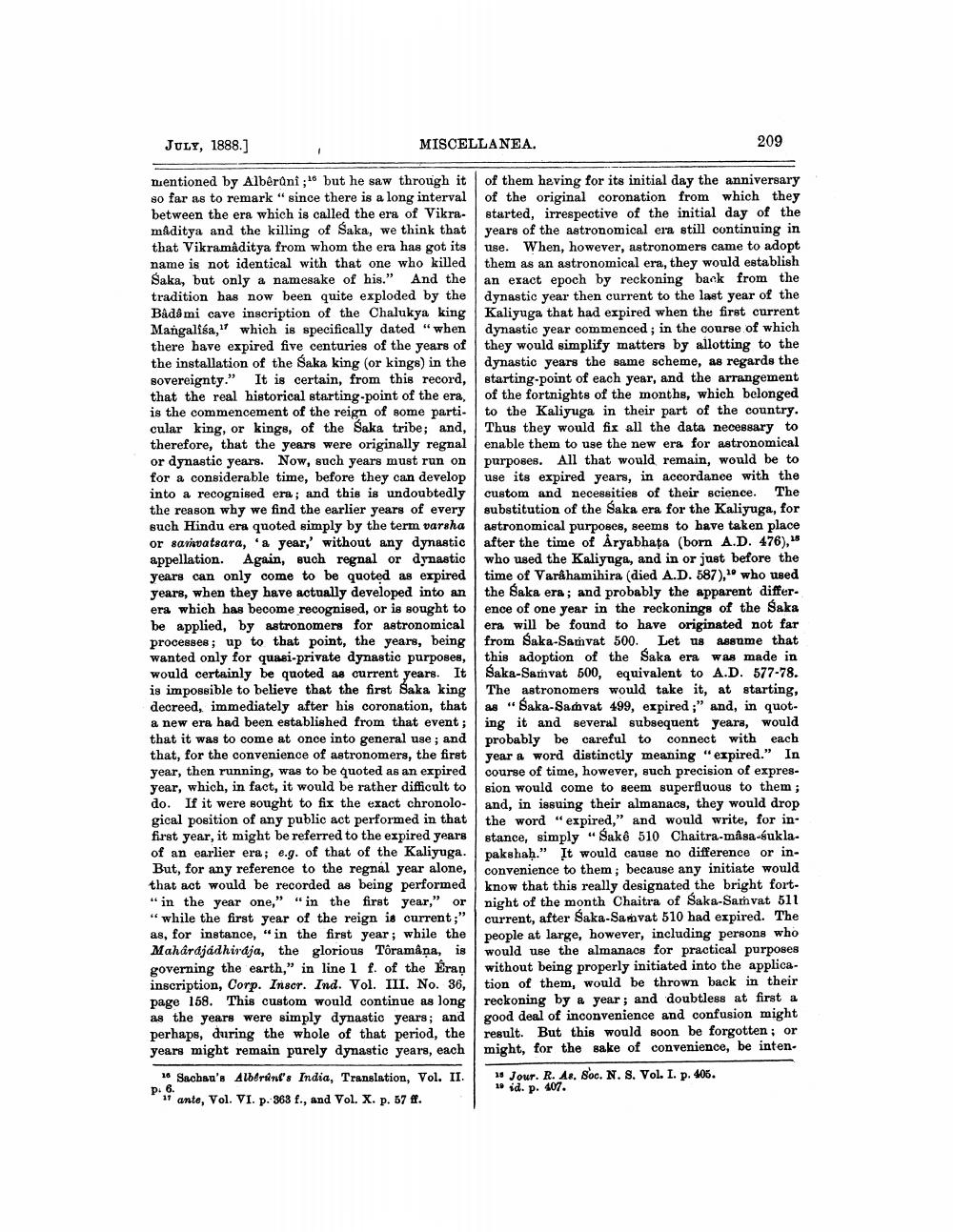________________
JULY, 1888.]
MISCELLANEA.
209
nuentioned by Alberuni ;16 but he saw through it of them having for its initial day the anniversary so far as to remark "since there is a long interval of the original coronation from which they between the era which is called the era of Vikra- started, irrespective of the initial day of the maditya and the killing of Saka, we think that years of the astronomical era still continuing in that Vikramaditya from whom the era has got its use. When, however, astronomers came to adopt name is not identical with that one who killed them as an astronomical era, they would establish Saka, but only a namesake of his." And the an exact epoch by reckoning back from the tradition has now been quite exploded by the dynastic year then current to the last year of the Båda mi cave inscription of the Chalukya king Kaliyuga that had expired when the first current Mangaliśa, which is specifically dated "when dynastic year commenced; in the course of which there have expired five centuries of the years of they would simplify matters by allotting to the the installation of the Saka king (or kings) in the dynastic years the same scheme, as regards the sovereignty." It is certain, from this record, starting point of each year, and the arrangement that the real historical starting point of the era, of the fortnights of the months, which belonged is the commencement of the reign of some parti. to the Kaliyuga in their part of the country. cular king, or kings, of the Saka tribe; and, Thus they would fix all the data necessary to therefore, that the years were originally regnal enable them to use the new era for astronomical or dynastic years. Now, such years must run on purposes. All that would remain, would be to for a considerable time, before they can develop use its expired years, in accordance with the into a recognised era ; and this is undoubtedly custom and necessities of their science. The the reason why we find the earlier years of every substitution of the Saka era for the Kaliyuga, for such Hindu era quoted simply by the term varsha astronomical purposes, seems to have taken place or samvatsara, 'a year,' without any dynastic after the time of Aryabhata (born A.D. 476), 25 appellation. Again, such regnal or dynastic who used the Kaliyuga, and in or just before the years can only come to be quoted as expired time of Varahamihira (died A.D. 587), who used years, when they have actually developed into an the Saka era; and probably the apparent differera which has become recognised, or is sought to ence of one year in the reckonings of the Saka be applied, by astronomers for astronomical era will be found to have originated not far processes; up to that point, the years, being from Saka-Samvat 500. Let us assume that wanted only for quasi-private dynastic purposes, this adoption of the Saka era was made in would certainly be quoted as current years. It Saka-Samvat 500, equivalent to A.D. 577-78. is impossible to believe that the first saka king The astronomers would take it, at starting, decreed, immediately after his coronation, that as "Saka-Samvat 499, expired;" and, in quot. a new era had been established from that event; ing it and several subsequent years, would that it was to come at once into general use; and probably be careful to connect with each that, for the convenience of astronomers, the first year a word distinctly meaning "expired." In year, then running, was to be quoted as an expired course of time, however, such precision of expres year, which, in fact, it would be rather difficult tosion would come to seem superfluous to them; do. If it were sought to fix the exact chronolo- and, in issuing their almanacs, they would drop gical position of any public act performed in that the word "expired," and would write, for infirst year, it might be referred to the expired years stance, simply "Sakê 510 Chaitra-masa-sukla. of an earlier era; e.g. of that of the Kaliyuga. pakshah." It would cause no difference or inBut, for any reference to the regnal year alone, convenience to them; because any initiate would that act would be recorded as being performed know that this really designated the bright fort " in the year one," "in the first year," or night of the month Chaitra of Saka-Samvat 511 " while the first year of the reign is current;" current, after Saka-Samvat 510 had expired. The as, for instance, “in the first year; while the people at large, however, including persons who Maharajadhiraja, the glorious Toramâņa, is would use the almanacs for practical purposes governing the earth," in line 1 f. of the Erap without being properly initiated into the applicainscription, Corp. Inscr. Ind. Vol. III. No. 36, tion of them, would be thrown back in their page 158. This custom would continue as long reckoning by a year; and doubtless at first a as the years were simply dynastic years; and good deal of inconvenience and confusion might perhaps, during the whole of that period, the result. But this would soon be forgotten; or years might remain purely dynastic years, each might, for the sake of convenience, be inten. 16 Sachan's Alberúnt's India, Translation, Vol. II. » Jour. R. As. Soc. N. S. Vol. I. p. 405.
10 id. p. 407. 11 ante, Vol. VI. p. 363 f., and Vol. X. p. 57 f.
D. 6.




